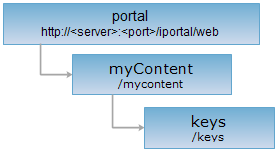
<mycontent_uri>/services[.<format>]
Keys is a resource that records the Key collection added by current user. After the SuperMap iPortal has been started, services registered or delegated by user will under protection. The authority shall be controlled meanwhile. Key is used for access protected service on iPortal.
Supported Methods:
Supported output formats: rjson, json, html, xml.

Implement the HTTP request on the following URI, where supermapiportal is the server name, with rjson being the output format.
http://supermapiportal:8090/web/mycontent/keys.rjson
GET: Gets the Key collection added by current user.
If this parameter is not set, then the list of keys on the first page will be returned. If the parameter is set, the list of the keys specified by the user will be returned. The request parameters are included in URI.
| Name | Type | Description |
| currentPage | int | Page number. |
| pageSize | int | Size of each page. |
Execute a GET request on the keys resource to return the list of keys added by current user. It includes the following fields:
| Field | Type | Description |
| content | List<KeyInfo> | Page content. |
| currentPage | int | The current page number. |
| pageSize | int | The page size. |
| searchParameter | SearchParameter | The search parameter for the current page. |
| total | int | The total record number. |
| totalPage | int | The total number of pages. |
The returned rjson format representation after implementing the GET request on the keys resource http://localhost:8090/web/mycontent/keys.rjson is as follows:
{
"content": [
{
"key": "ukQceZ3yKtBGsZF6um5dSuho",
"clientType": "SERVER",
"id": 4,
"limitation": "192.168.120.40",
"name": "app",
"serviceIds": "1,2",
"userName": "admin"
}
],
"currentPage": 1,
"pageSize": 10,
"searchParameter": null,
"total": 1,
"totalPage": 1
}
POST: Adds a new Key.
Following arguments need to be passed in the request sent.
| Name | Type | Description |
| name | String | Name of the key. |
| serviceIds | String | ID Arrays of the authorised services. |
| clientType | ClientType | These types of client are allowed to access services: WEB,MOBILE,SERVER. |
| limitation | String | Limited characters for service access, vary by cilent types. WEB: source site referer; MOBILE: mobile applicaton ID; SERVER Request: request source site IP. |
The structure of the response resource representation is as follows:
| Field | Type | Description |
| succeed | boolean | Whether it's successful to modify the key. |
| error | Httperror | Error message. This field will not be created if the key has been modified successfully. |
Implement a POST request on the keys resource: http://localhost:8090/web/mycontent/keys.rjson to add a new key. The request is as follows:
{
"name": "app1",
"serviceIds": [
2
],
"clientType": "SERVER",
"limitation": "192.168.120.40"
}
The response result in rjson format returned is as follows:
{ "succeed": true}
PUT: Modifies Key parameters.
Execute PUT request for keys resource. Parameters passed in the request body are as follows:
| Name | Type | Description |
| id | int | ID of the key that need modification. |
| name | String | Name of the key. |
| serviceIds | String | ID Arrays of the authorised services. |
| clientType | ClientType | These types of client are allowed to access services: WEB,MOBILE,SERVER. |
| limitation | String | Limited characters for service access, vary by cilent types. WEB: source site referer; MOBILE: mobile applicaton ID; SERVER Request: request source site IP. |
The response result returned is as the following:
| Field | Type | Description |
| succeed | boolean | Whether it's successful to modify the key. |
| error | Httperror | Error message. This field will not be created if the key has been modified successfully. |
Implement a PUT request on the keys resource: http://localhost:8090/web/mycontent/keys.rjson to modify the parameters of the key and to add a ccessible service. The request body is as follows:
{
"id": 5,
"name": "app1",
"serviceIds": [
1,
2
],
"clientType": "SERVER",
"limitation": "192.168.120.40"
}
The response result in rjson format returned is as follows:
{ "succeed": true}
Deletes specified Key, batch operation supported. Pass the ID arrays of keys to delete within url.
The structure of the response resource representation is as follows:
| Field | Type | Description |
| succeed | boolean | Whether it's successful to delete keys. |
| error | Httperror | Error information. This field wont be created if the keys have been deleted successfully. |
Implement the DELETE request on the keys resource http://localhost:8090/web/mycontent/keys.rjson?ids=[4,5] to delete keys with ID 4 and 5. Return rjson results:
{ "succeed": true}
Asks for the response identical to the one that would correspond to a GET request, but without the response body. This is useful for retrieving meta-information written in response headers, without having to transport the entire content. The meta-information includes the media-type, content-encoding, transfer-encoding, content-length, etc.
HEAD request can be used to check whether the keys resource exists, or whether the the client has the permission to access it. It can also determine if the keys resource supports an output format <format> if performed on a URI with .<format> included.